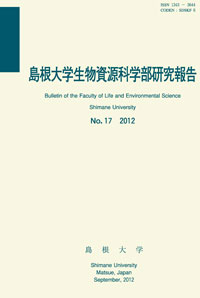島根大学生物資源科学部
ISSN:2435-0885(オンライン)
ISSN:1343-3644(冊子体)
なお、冊子体の刊行は23巻まで
ISSN:1343-3644(冊子体)
なお、冊子体の刊行は23巻まで

ダウンロード数 : ? 件
この文献の参照には次のURLをご利用ください : https://ir.lib.shimane-u.ac.jp/3526
島根大学生物資源科学部研究報告 3
1998-12-20 発行
異なる光環境と施肥強度のもとで栽培されたスギとヒノキの2年生実生の成長
Effects of light intensity and fertilization on growth rate of two-year-old seedlings of Japanese red cedar (Cryptomeria japonica D.Don) and Japanese cypress (Chamaecyparis obtusa Endl.)
金塚 洲
ファイル
内容記述(抄録等)
Two year-old seedlings of Japanese red cedar(sugi)and Japanese cypress(hinoki)were grown under two levels of light intensity and fertilizer in a nursery of Honjoh Expenmental Farm, Shimane University.Totally fourblocks of treatments were set in the nursery according to the random block method.We measured relative growth rate(RGR)of diameter at 5cm above ground, height and D^2H at each treatment block. The RGR in stem elongation ranged from 138 to 183 for sugi and from 132 to 162 for hinoki. Diameter increment ranged from 157 to 227 for sugi and from 140 to 219. Seedlings grown under full sunlight showed larger elongation of stems and increment of diameter than the seedlings under shaded condition. Effect of fertilization on hinoki seelings growth was significantly positive in full sunlight block. Even though it was statistically insignificant, its effect was negative in shaded block. Growth of sugi seedlings depends solely upon light availablity. Whereas hinoki seedlings require light primarily and nutrient secondary for their growth.
樹木はその成長に必要な資源として, 光,水分,炭素源を含む養分物質を要求する。これらの三要素のいずれが欠けても健全な成長が阻害される。農耕地とは異なり,天然生林はもちろん人工林においてさえも森林では,潅水や施肥などの施業は通常はされない。日本のように大陸東岸の海洋性気候に属し比較的降水量が年間を通して得られる地域では,林地における水分制限はそれほど深刻でない。天然生林や複層林施業下の人工林では林冠が複数の層位からなり、林冠最上部に葉群をもつ個体以外は光制限になる.このため多くの森林植物は光により成長が制限されていると考えられる.森林の更新に重要な役割を果たす実生や幼木は林床の光環境の悪い空間に生育場所を限定される(Walters & Reich 1997). さらに,林床における窒素やリンなどの養分は空間的に不均一に分布し,これら養分の可給性の大小も光と同様に成長を制限している(e.g. Zak & Pregitzer 1985).
本報告では,日本国内の代表的な造林樹種であるスギとヒノキの2年生実生苗を異なる光環境および異なる養分可給性下で栽培し,それぞれの環境に対する実生苗の成長反応を検討する.
樹木はその成長に必要な資源として, 光,水分,炭素源を含む養分物質を要求する。これらの三要素のいずれが欠けても健全な成長が阻害される。農耕地とは異なり,天然生林はもちろん人工林においてさえも森林では,潅水や施肥などの施業は通常はされない。日本のように大陸東岸の海洋性気候に属し比較的降水量が年間を通して得られる地域では,林地における水分制限はそれほど深刻でない。天然生林や複層林施業下の人工林では林冠が複数の層位からなり、林冠最上部に葉群をもつ個体以外は光制限になる.このため多くの森林植物は光により成長が制限されていると考えられる.森林の更新に重要な役割を果たす実生や幼木は林床の光環境の悪い空間に生育場所を限定される(Walters & Reich 1997). さらに,林床における窒素やリンなどの養分は空間的に不均一に分布し,これら養分の可給性の大小も光と同様に成長を制限している(e.g. Zak & Pregitzer 1985).
本報告では,日本国内の代表的な造林樹種であるスギとヒノキの2年生実生苗を異なる光環境および異なる養分可給性下で栽培し,それぞれの環境に対する実生苗の成長反応を検討する.
About This Article
Other Article
